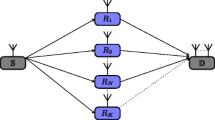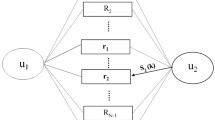Abstract
In this paper, we analyze the pairwise error probability (PEP) of distributed space–time codes, in which the source and the relay generate Alamouti space–time code in a distributed fashion. We restrict our attention to the space–time code construction for Protocol III in Nabar et al. (IEEE Journal on Selected Areas Communications 22(6): 1099–1109, 2004). In particular, we derive two closed-form approximations for PEP when the relay is either close to the destination or source and an upper bound for any position of the relay. Using the alternative definition of Q-function, we can express these PEPs in terms of finite integral whose integrand is composed of trigonometric functions. We further show that with only one relay assisted source-destination link, system still achieves diversity order of two, assuming single-antenna terminals. We also perform Monte-Carlo simulations to verify the analysis.
Similar content being viewed by others
References
Nabar R.U., Bölcskei H., Kneubühler F.W. (2004) Fading relay channels: Performance limits and space–time signal design. IEEE Journal on Selected Areas Communications 22(6): 1099–1109
Foschini G.J. (1996) Layered space–time architecture for wireless communication in a fading environment when using multielement antennas. Bell Labs Technical Journal 1(2): 41–59
Telatar I.E. (1999) Capacity of multi-antenna Gaussian channels. European Transactions on Telecommunications 10(6): 585–595
Tarokh V., Seshadri N., Calderbank A.R. (1998) Space–time codes for high data rate wireless communication: Performance criterion and code construction. IEEE Transactions on Informational Theory 44(2): 744–765
Tarokh V., Jafarkhani H., Calderbank A.R. (1999) Space–time block codes from orthogonal designs. IEEE Transactions on Informational Theory 45(5): 1456–1467
Sendonaris A., Erkip E., Aazhang B. (2003) User cooperation diversity—Part I: System description. IEEE Transactions on Communications 51(11): 1927–1938
Sendonaris A., Erkip E., Aazhang B. (2003) User cooperation diversity—Part II: Implementation aspects and performance analysis. IEEE Transactions on Communications 51(11): 1939–1948
Laneman J.N., Tse D.N.C., Wornell G.W. (2004) Cooperative diversity in wireless networks: Efficient protocols and outage behavior. IEEE Transactions on Informational Theory 50(12): 3062–3080
Laneman J.N., Wornell G.W. (2003) Distributed space–time-coded protocols for exploiting cooperative diversity in wireless networks. IEEE Transactions on Informational Theory 49(10): 2415–2425
Jing Y., Hassibi B. (2006) Distributed space–time coding in wireless relay networks. IEEE Transactions on Wireless Communication 5(12): 3524–3536
Dohler M., Li Y., Vucetic B., Aghvami A.H., Arndt M., Barthel D. (2006) Performance analysis of distributed space–time block-encoded sensor networks. IEEE Transactions on Vehicular Technology 55(6): 1776–1789
Hua, Y., Mei, Y., & Chang, Y. (2003). Wireless antennas—making wireless communications perform like wireline communications. In IEEE AP-S Topical Conference on Wireless Communication Technology, Honoluu, Hawaii, Oct. 2003 (pp. 1–27), Invited paper.
Chang, Y., & Hua, Y. (2004). Diversity analysis of orthogonal space–time modulation for distributed wireless relays. In IEEE International Conference on Acoustics, Speech, and Signal Processing, Montreal, Canada, May 2004 (pp. 561–564).
Duong, T. Q., Ha, D.-B., Tran, H.-A., & Vo, N.-S. (2008). Symbol error probability of distributed-Alamouti scheme in wireless relay networks. In IEEE 67th Vehicular Technology Conference, Marina Bay, Singapore, May 2008 (pp. 648–652).
Alamouti S.M. (1998) A simple transmit diversity technique for wireless communications. IEEE Journal on Selected Areas Communications 16(8): 1451–1458
Simon M.K., Alouini M.-S. (2000) Digital communication over fading channels: A unified approach to performance analysis. Wiley, New York
Gradshteyn I.S., Ryzhik I.M. (2000) Table of integrals, series, and products, 6th ed. Academic, San Diego
Author information
Authors and Affiliations
Corresponding author
Additional information
This paper was presented in part at the 7th International Symposium on Communications and Information Technologies, Sydney, Australia, Oct., 2007.
Rights and permissions
About this article
Cite this article
Duong, T.Q., Nguyen, NT., Hoang, T. et al. Pairwise Error Probability of Distributed Space–Time Coding Employing Alamouti Scheme in Wireless Relays Networks. Wireless Pers Commun 51, 231–244 (2009). https://doi.org/10.1007/s11277-008-9640-9
Received:
Accepted:
Published:
Issue Date:
DOI: https://doi.org/10.1007/s11277-008-9640-9




